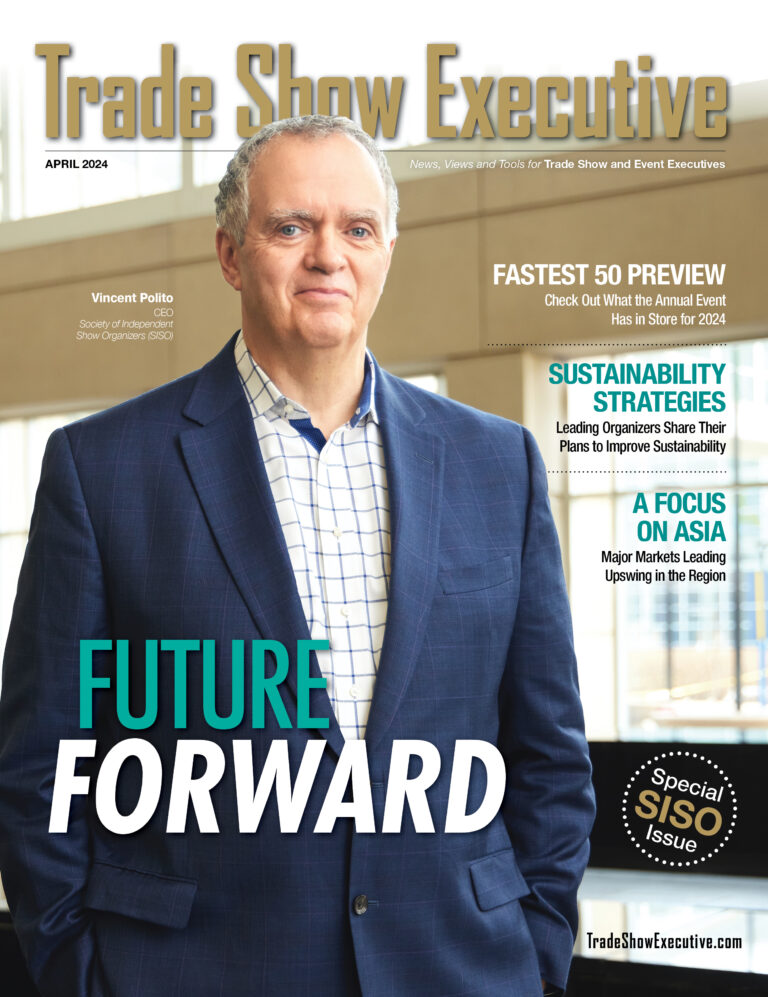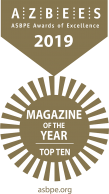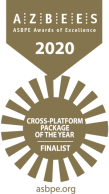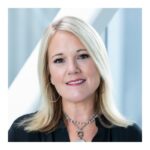Chicago, IL – “The stage at Trade Show Executive’s Fastest 50 Awards & Summit was only a few feet high but it offered a lofty view of the future of trade shows,” said Darlene Gudea, president of Trade Show Executive Media Group. Organizers of the fastest-growing shows were honored for growing their net square footage, number of exhibitors and attendance by leaps and bounds in 2012. Fourteen organizers were honored further with crystal trophies for their ability to leapfrog over the other speed demons – in percentage growth or in sheer numbers. And during the Fastest 50 Summit, industry leaders and outside experts covered the bases, from tips on new business models and strategies for growing your show at Fastest 50 speeds, to hitting social media homeruns and turning detractors into advocates.
“We were very pleased with the turnout,” said Diane Bjorklund, TSE’s vice president of events. The 2013 Fastest 50 was held for the first time in Chicago and drew a record attendance of 120 registered delegates, reflecting a ratio of 60% organizers and 40% service providers. “The Fastest 50 drew a true cross-section of the exposition industry, from show managers of niche shows to the CEOs of the largest associations and independent organizers,” she added. The retail sector was most heavily represented, followed by organizers from construction, manufacturing, medical/healthcare and technology, reflecting a microcosm of the trade show industry and leading to interesting viewpoints and discussions.
High Achievers
Collectively, the Fastest 50 grew 14.3% in exhibit space, 14.3% in the number of exhibiting companies, and 19.1% in attendance. By comparison, shows in the TSE Composite Index of Trade Shows (the Trade Show Executive Dashboard), which includes the entire U.S. exhibition industry, increased 2.4% in exhibit space, 1.5% in exhibitors and 2.9% in attendance. The top-ranked show, The Running Event,left a lot of shows in a cloud of dust with an 88% increase in exhibit space — nearly 37 times the average show growth in 2012.
And The Winner Is …
During the awards dinner, 14 of the top sponsors announced the winners of Fastest 50 Grand Awards and presented a crystal trophy to the organizer who ranked among the very elite in a highly competitive awards program.
The big winners of the evening were:
- Carol Fojtik, senior vice president of Hall Erickson, who struck gold with MINExpo and Exhibitor 2012, winning three crystal Grand Awards and five plaques. She practically needed a dozer or forklift to haul her winnings back to the office.
- Sharon Enright, vice president of the trade show division, Business Journals, Inc., who won one crystal Grand Award and 11 plaques, which stacked up almost higher than herself despite her eye-catching designer heels. BJI organized five shows in the Fastest 50, including AccessoriesTheShow-January; AccessoriesTheShow-February; Fame; Moda Manhattan; and MRket.
- Bob Harar, chairman and CEO of National Trade Productions, winning one crystal Grand Award and six plaques for three shows: the EVS26/Electric Vehicle Symposium, Coverings, and the American Society of Plumbing Engineers Convention & Exposition.
Here’s a look at the full list of Grand Award winners:
Highest Growth in NSF of Exhibit Space by Percentage (Annual Show):
The Running Event, which grew 88% to 94,000 nsf
Highest Growth in NSF of Exhibit Space in Sheer Numbers (Non-Annual Show):
MINExpo, which grew by 271,060 nsf to 852,030 nsf
Highest Growth in NSF of Exhibit Space in Sheer Numbers (Annual Show):
International CES, which grew by 171,246 nsf to 1,827,557 nsf
Highest Growth in Number of Exhibiting Companies by Percentage (Annual Show):
EVS26/Electric Vehicle Symposium, which grew 60% from 125 exhibitors to 200 exhibitors
Highest Growth in Number of Exhibiting Companies by Percentage (Non-Annual Show):
MINExpo, which dug up 45.4% more exhibitors, expanding to 1,868 from the 1,285 at its last show in 2008
Highest Growth in Number of Exhibiting Companies in Sheer Numbers (Annual Show):
IMEX America, which grew by 546 exhibitors to 2,413 exhibitors
Highest Growth in Attendance by Percentage:
SURTEX, which grew 43% to 7,150 attendees
Highest Growth in Attendance in Sheer Numbers (Non-Annual Show):
International Manufacturing Technology Show (IMTS), which grew by 17,789 attendees to 100,200 attendees
Highest Growth in Attendance in Sheer Numbers (Annual Show):
Offshore Technology Conference (OTC), which grew by 11,220 attendees to 89,865 attendees
Fastest-Growing Medical Show:
American Psychiatric Association Annual Meeting, with a blended average growth rate of 28%
Organizer with the Greatest Number of Fastest 50 Shows:
Business Journals Inc., with five shows including: AccessoriesTheShow – January; AccessoriesTheShow – February; Fame; Moda Manhattan; and MRket.
Fastest 50 Double Header (the Gold 100 show with the highest Fastest 50 growth):
SGIA Expo, produced by the Specialty Graphics Imaging Association, with a blended average growth rate of 21%
Fastest 50 Grand Slam (Non-Annual Show that grew the fastest in all three metrics):
MINExpo, which achieved a blended average growth rate of 44%
Fastest 50 Grand Slam (Annual Show that grew the fastest in all three metrics):
The Running Event, which achieved a blended average growth rate of 44%
Networking: Chicago Style
With a leading cast of movers and shakers in the trade show industry, networking took center stage. The Fastest 50 facilitated that process by creating unique special events that highlighted some of Chicago’s notable landmarks:
- The Chicago Cubs Baseball Game Outing, sponsored by the Atlantic City Convention & Visitors Authority, with lunch sponsored by Mobile Event Guide, kicked off the event at historic Wrigley Field. Attendees watched the Chicago Cubs take on the St. Louis Cardinals from the Budweiser Bleacher Suite in center field. Cubs Owner Tom Ricketts stopped to meet and greet attendees, as well as give away a wide array of prizes, including bases from the game and autographed baseballs.
The Fastest 50 Opening Reception, sponsored by Global Experience Specialists (GES), was held at the legendary Harry Caray’s Italian Steakhouse & Bar. Attendees mixed and mingled at this must-see Chicago institution, named the “Best Steakhouse in Chicago” by the Chicago Tribune Dining Poll.
Summit Sessions Run the Gamut
The summit featured fast-paced sessions on best practices, case studies and issues facing show managers. Organizers of the fastest-growing shows shared the strategies and tactics that made their success stories possible.
Keynote speakerJonah Berger, assistant marketing professor at the Wharton School at the University of Pennsylvania and author of best-selling book Contagious, Why Things Catch On, opened the Fastest 50 with a thought-provoking presentation on the science behind social communication.
How do you get exhibitors and attendees talking about your show? “There is a formula to engineer content to make it more viral or talkable,” said Berger. “You can craft contagious content. The key word is here is craft.”
Make people feel like insiders, he advised. “If people feel like they have access to a secret, they will want to share it,” said Berger. “People want to talk about things that make them look good.”
How do you turn customers into advocates? “Activate your community,” said Berger. “Give them something to talk about by finding your inner remarkability,” he suggested. “What makes your show surprising, novel or interesting? Think about how you can get just one person to tell someone else about the conference or event.”
Another way to get people talking about your brand: Make the private public. “If it’s built to show, it’s built to grow,” said Berger. He offered the example of the Apple logo on the back of its computers and its use of white headphones when the standard was black. In addition, he cited the use of colored lanyards for VIPs and other attendee groups at South by Southwest.
Insider’s View of SXSW Interactive Festival
Hugh Forrest, director of the South by Southwest Interactive Festival, discussed how he has been able to grow the event from 5,000 attendees in 2005 to 30,000 registrants in 2013. “Markets are conversations,” said Forrest. “The more you converse with your audience, the stronger you are.”
One way he creates a dialogue with his customers is through the show’s “Panel Picker.” The community submits ideas about nine months before the event, and the online community votes on the topics. “It gets people talking about the show in July and August when they normally would not be,” said Forrest. For this year’s March show, 3,500 ideas were submitted.
“My job is really about community management,” said Forrest. “Let the community pull you. They know better than you do.”
For example, he said his staff is in the process of writing 200 feedback letters to registrants who completed a post-event survey and were unhappy with some aspect of the event. “We are receptive to their critiques,” he said. “Community management is very, very difficult, but it’s worth the effort. You can turn detractors into advocates.”
Ready to Buy? Sell? Partner?
Greg Topalian, senior vice president, Reed Exhibitions, discussed what he looks for when evaluating shows to buy.“We are looking for good topline growth,” he said.“Have a clear growth plan, and tell me why you think your show will grow. Don’t assume the buyer will know.”
Ty Bobit, president and CEO, Bobit Business Media, talked about his recent sale of the Hot Rod and Restoration Show to National Business Media. He decided to sell the show because it wasn’t growing and it didn’t offer synergies with the other shows in his portfolio. “The sale has freed up resources within our small company,” he said. “We have launched three events in the last five months.”
One key issue to consider: whether to go directly to the buyers or use a broker. Since the sale price for the Hot Rod and Restoration Show was comparably lower, Bobit decided to go directly to a strategic buyer with other complimentary properties.Reed Exhibitions works with brokers and buyers. “From the buyer’s perspective, we prefer working directly with the sellers so we have the opportunity to connect with them,” said Topalian. “But a broker can be a real benefit to a seller, and they will keep the sale moving on a timeline.”
Topalian also announced that Reed has recently approved an “angel program.” [More details will be published in a future issue of Trade Show Executive]. The company will be looking to make financial investments in small shows and businesses. “We want to offer resources or staffing to help smaller events grow,” he said. “I’m really excited about this new program.”
Strategies of Fastest 50 Growth Leaders
Moderater Phil McKay, president & CEO of nGage Events, and a panel of industry leaders, discussed what they are doing right now to keep their events on the fast track.
How did Hanley Wood Exhibition’s International Pool | Spa | Patio Expo grow exhibit space by 27.2% and exhibiting companies by 13.2% in 2012, despite the fact that the show serves an industry that sells luxury items? “We’ve become a more sales-centric organization,” said Dana Teague, group director, Hanley Wood Exhibitions. “We’ve empowered the sales teams. They have the ability to earn more income, and we send account executives out into the field now.”
She also said Hanley Wood is signing multi-year agreements with some anchor exhibitors. “You will lose some margin because you will have to freeze prices,” she said. Co-location is another strategy Hanley Wood is employing to grow events. For example, Hanley Wood’s Kitchen & Bath Industry Show will co-locate with the International Builders’ Show to create Design and Construction Week in Las Vegas beginning in 2014. In 2015, Design and Construction Week will expand further with the addition of Hanley Wood’s SURFACES and StonExpo/Marmomacc Americas.
Other show organizers, such as Advanstar Communications Inc., are focused on growing by expanding online opportunities. For example, earlier this year, MAGIC launched Shop the Floor, which features virtual showrooms for exhibitors. “It’s geared toward b-to-b now, but our hope is to expand to b-to-c,” said Leslie Gallin, vice president, FN PLATFORM, which grew attendance by 32.3%, exhibiting companies by 21.3% and nsf of exhibit space by 24.8% for its February 2012 show. “If we can engage consumers, it is better for all of us.”
John Gallagher, president and CEO, Messe Frankfurt North America, said the “Tulip Club” has been successful at bringing key buyers to Texworld USA (Winter Edition) and keeping them there longer. The show offers complimentary car service to and from the event, lunch and refreshments, and a private lounge for VIP buyers only. Texworld USA (Winter Edition) grew exhibiting companies by 10.2% and total attendance by 22.5% in 2012.
Power Lunch
Kerry Gumas, president and CEO of Questex Media Group LLC, was the latest Leader & Legend to take the stage with TSE columnist Bob Dallmeyer.
Gumas discussed how he was able to successfully navigate Questex through bankruptcy and reposition the company. “It’s a complex and costly process, so if it’s necessary to pursue such a process, it’s important to select the right advisors — legal and banking — who can function well as an extension of the team,” said Gumas.
He told Dallmeyer and the crowd that the next 10 years will be an exciting time in the industry, but he warned there will be continued pressure on pricing and the total cost of participation. “We are already seeing bundled pricing and dynamic pricing replace fixed pricing in many shows,” said Gumas. “This trend will accelerate and as organizers seek to deliver more services as part of bundled models.” (See page 34 in the June issue of Trade Show Executive for the complete interview.)
Is the Convention Center Model Broken?
Moderated by TSE editor-at-large Danica Tormohlen, a panel discussed the changes afoot in the longstanding relationship between show organizers and convention centers owned by cities that are urgently searching for new revenues.“There’s been a lot of talk in recent years about whether the current convention center model is sustainable going forward,” said Tormohlen. “Can convention centers continue to operate as loss-leaders in their communities?”
“The short answer is no,” said James Rooney, executive director, Massachusetts Convention Center Authority (MCCA). “The traditional model of operating a convention center at a loss with the premise of bringing outside dollars into a community is not sustainable.”
MCCA has invested $500,000 in a strategy and product development team to explore new revenue streams for the three convention facilities that MCCA manages. “Nothing is off the table,” said Rooney. “That may mean creating, executing and partnering on trade shows, or that may mean developing new products and services to provide alternate revenue streams.”
Mark Zimmerman, general manager of the Georgia World Congress Center (GWCC), said the Atlanta-based facility is renting space in the short term for movie production and has signed longer-term agreements to house the College Football Hall of Fame and the Junior Achievement Discovery Center on its campus. In addition, they are partnering with show organizers to launch events.
David Audrain, president & CEO, Clarion Events North America, discussed his partnership with the GWCC to launch the Atlanta Foodservice Expo in October. “They are waiving some of the costs for rent and food & beverage,” he said. “GWCC is sharing in some of the risk, but they will also share in some of the revenue.”
Tony Calanca, executive vice president, Advanstar, said he doesn’t have a conceptual objection to venues producing events. “But it may impact my decision to hold an event there,” he said.
Burning Issues
Moderated by Kevin Johnstone, a panel of industry leaders discussed some of the top issues facing the industry, including economic impact, government regulations and aging convention centers.
When asked if facilities have the infrastructure needed to meet the demands of today’s exhibitors and attendees, show organizers said Wi-Fi in convention centers is the biggest issue. “We receive a lot of complaints about the cost, speed and consistency of the Wi-Fi,” said Robbi Lycett, vice president, conventions & conferences, for the Biotechnology Industry Organization.
Lycett said more exhibitors and sponsors are asking for help in locating very targeted groups of attendees. While the show’s business forum facilitates 25,000 meetings for exhibitors and attendees in a separate space off the show floor, exhibitors are also requesting more events on the show floor. “It’s given us the opportunity to produce customized events for them at the show,” she said.
Liz Crawford, show director and senior marketing director, Nielsen Expositions, talked about the burning issues facing her company. She noted that Nielsen is measuring the “net promoter score” for exhibitors and attendees. “We ask them on a scale of 1 to 10 if they would recommend the show to others,” she said. “Our plans and goals are based, in part, on those scores.”
On the contractor side, package pricing for exhibitors continues to be a trend, said John Patronski, executive vice president, Global Experience Specialists (GES). For example, IMTS offer custom block pricing, which includes not only freight but also unloading and assembling. He noted that a number of organizers are looking at variable pricing for exhibit space. “We can provide data on traffic, density and dwell time in a particular area of the show floor to support that,” said Patronski. Ethnometrics, a division of GES, uses video technology to measure and evaluate key metrics in face-to-face marketing.
Stay Tuned
Nominations for the 2013 Fastest 50 will open later this year. TSE is currently accepting RFPs from cities interested in hosting the 2013 Fastest 50 Awards & Summit.
The Fastest 50 directory is available free to subscribers and sponsors, and is not posted online, unlike other Trade Show Executive resources. To purchase a copy of the directory for $179, contact Leticia Cotton at lcotton@tradeshowexecutive.com
Reach Darlene Gudea, TSE president at (760) 930-9111 or dgudea@tradeshowexecutive.com; Diane Bjorklund, TSE vice president of events, at (630) 312-8915 or dbjorklund@tradeshowexecutive.com











